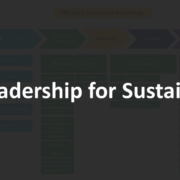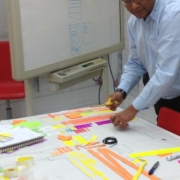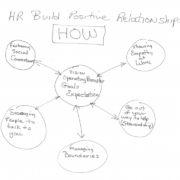Lean HR: Leadership for Sustainment
(Reposted by permission of the author from LinkedIn)
Leadership is the key to the sustainment of an HR environment of excellence. The role of the HR leader is to support the delivery of product or process that meet customer expectations and develop the organization to achieve future requirements. HR is expected to lead the charge for the implementation of mutual trust and respect. They are expected to know the future and its implications to take care of the people. All these factors are major in the system of work and a continuous improvement environment. Their actions and expectations drive the attainment of an environment of continuous improvement and sustain all the current standards for the HR Golden Standard.
It is very difficult to achieve change, but sustainment of the change is much more difficult. In this day where change happens constantly, we hear about and see changes that are touted as the ultimate improvement of the world of work. Everything from physical changes such as moving a corporate headquarters to team-based engagement that leads to enhanced competency, to process changes allow the product to flow smoothly and evenly to the customer. The challenges from the operations are real and deserve a systematic change effort from everyone to achieve change that can be sustained.
All of these are worthy examples, but experience has taught me that a change is momentary and must be treated as a part of the system and not lauded as achievement that is isolated. An isolated change where sustainment is a major factor in its implication will not sustain itself. They are much easier to create and implement but have the characteristic of not improving the system. Making these changes and not having ways to secure the system doom them. In a culture that is focused on sustainment, all factors which contribute to its continuance are carefully managed with clear expectations for process management, role changes, support and improvement attainment.
How does this happen? The answer lies in the careful consideration by management to not only improve processes but to do it in a complete way so they can be predictable, reliable and able to deliver sustained expectations of the system of work.
In HR, our role involves carefully selecting and training leaders to be able to create and sustain an environment that is not disruptive and will be sustained over-time. To many the response to this is “yes” in intention and “not so sure” in actual application. In HR, we clearly understand this because we deal with the consequences. We know that the intentions may be good, but behavior is the element that we must monitor.
This, like most problems which are viewed as an opportunity to intervene, which are called burst in your face problems, each present to us an opportunity to create prevention through current efforts to drive future behavior. Interventions can be powerful but only deal with an existing problem. It is a much better strategy to create the environment and the behavioral expectations that do not lead to the need for intervention. The most relevant efforts to sustain behavior are those that resolve issues before they exist. The preventions are as carefully crafted as interventions but have the advantage of avoiding future problems.
Prevention begins with a clear understanding of what it takes to create the environment of mutual trust and respect while accomplishing all the objectives of the organization. It is clear to every HR person that this is insufficient unless it is followed by appropriate behavior to support the intentions. To create the best environment for this you must consider the first major interaction, selection, and use it to prepare personnel to behave to the expectations. Selection can be powerful if you use a behavioral approach to find those who have demonstrated your behavioral expectations in their experience. We learned that being exhaustive in the number of behaviors chosen can be a burden and not the best way to select. We at Toyota had over 20 competencies that we used initially to select and found that only 4 of them positively correlated with success on the job. Consequently, the selection process was reduced in scope and intensified in demonstrations of those 4 behaviors. This allowed us to develop a “day in the life” simulation that was a reliable demonstration of behaviors required on the job. I believe this approach delivered the best workforce we could ever have hoped for serious intervention.
Using a prevention approach, we put in place an assimilation process that not only included the usual company identifications messages but also extended to over 22 weeks of on-the-job training, physical training and interaction with their teams to establish a basis of teamwork. This allowed the newly selected person to stay injury free, be part of the team and experience all the behavioral expectations necessary for long term success.
In the daily life the concept of mutual trust and respect was at the forefront of the individual as it was demonstrated every day. HR monitored this continuously to ensure the intended behaviors were indeed realized. This process of monitoring involved the creation of a successful environment where leadership treated everyone in every circumstance with mutual trust and respect. HR constantly tracked “critical incidents” to validate the competencies and the performance of all members. Every manager knew the expectations derived from the HR Gold Standards were not just words but living testimony to how the organization would be conducted. Leaders were expected to deliver and train to all the expectations. HR was a significant performance level determinant through their coaching and the performance appraisal program.
The primary action taken by the leader is leading by example. It is a fundamental assumption by a continuous improvement organization that this takes place. If I am a member of the organization and I experience a contradiction in behavior, it is a certainty that I will believe what I experience and negate anything I hear because of the contradiction. This is so fundamental that experienced behavior will cause the member to disregard any statement of intent. This is why the organization must guard against these discrepancies and enable the system of sustainment to support them until behavior matches intent. This is a fundamental role for HR to not supersede behavior but support and train for success and predictability over the entire organization.
Opportunities exist every day in delivering the goals, going to gemba, experiencing routines practiced and communicating organizational capacity. HR must be careful to insist that goals and targets are very important, but the behavior used to deliver them has a lasting and principled impact on delivering them consistently throughout the future. Members must be able to experience success on the job, equity in treatment and firm commitment to the policies as they are designed. This message sets the intent of an organization who believes that success of the individual is paramount, and problems are opportunities to enable positive accountability on everyone’s part.
The behavior of experimentation plays a vital part in the process of sustainability. Making anything over and over can be boring. Through the encouragement and support of trying new things, the member experiences a vital connection between their direct knowledge of the job and the organizational support of continuous improvement. Even the act of experimenting involves significant support from the organization. The encouragement must lead to an enactment of support including time to create and try and idea. Every experiment involves the mutual trust and respect belief causing the member to experience the organization as supportive of ideation. Additionally, leaders in the organization must know and behave with the belief that experimentation is an important act necessary to become part of the family of work. These acts, if sustained, represent a clear association of the company with the member as being a part of the organization’s commitment.
Along with experimentation support comes the decision-making process. Even the best behavior can be subverted if the decision-making is slow and bureaucratic. Part of the intent is to keep ideas small and easy to implement. Many times, if the process for getting approval is drawn out it can either discourage the member or create a real barrier for commitment to improvement. By having the process for decisions being as close to the member as possible, the steps become simple and easy. Only if the idea is very large in scope does it become more bureaucratic and require decision above the supervisor. This in effect values small, easy to implement ideas and promotes the ease of application by the member.
The preceding are examples of how the organization must first look at sustainability with the leader following with behavior will sustainability be possible. If either part is missing, then sustainability is missing. The leader guides and directs the expected behaviors and are also held accountable to them as the most important measure of success in participation. This disconnect is damaging to morale and performance.
The leader is also responsible for propagation of good ideas across their organization and other doing similar work. This horizontal process called Yokoten in the Toyota world sets the requirement for good ideas being spread where they may fit. The relationship across horizontal boundaries requires a receptivity by all departments. This receptive relationship is set in many ways so that the level of “siloing’ is minimized or eliminated. The team is clearly defined as the entire organization. HR works issues of compartmentalization, including silos, and defines and coaches to these expected behavior. These standards of behavior are not optional and must be embraced by the leader as their firm commitment to sustainability of the organization.
The last element I will discuss is one constantly overlooked in most organizations. It is a not so subtle reminder of the value of the “basics”. It is an organizational mandate that periodically the entire organization will conduct assessments of the sustainment of the basics as mechanism for long term sustainment. Each leader is responsible for their area and HR is to monitor and support the assessment and correction of behavior that does not support the intent. These coaching activities are considered primary during the assessment and are not short-cut because of choices to ignore them. The leader holds the accountability to support the assessment and the correction process and are evaluated based on the interaction with all involved.
It is the teamwork from all members in the organization that is expected. HR knows the fundamental value of sustainment and supports its attainment. It is through sustainment, that the assumption of value delivered is examined. A one-time act is not valued. To that end it is HR that sets the policy, observes and coaches to appropriate behavior and assures the system of accountability is working. Their role is vital and not to be subjugated. They are the enactment of teamwork, accountability and they work for everyone.

 2019, Total Systems Development, Inc.
2019, Total Systems Development, Inc.



 Total Systems Development, 2019
Total Systems Development, 2019 2019, Total Systems Development
2019, Total Systems Development 2019, Total Systems Development, Inc.
2019, Total Systems Development, Inc. 2019, Total Systems Development, Inc.
2019, Total Systems Development, Inc.